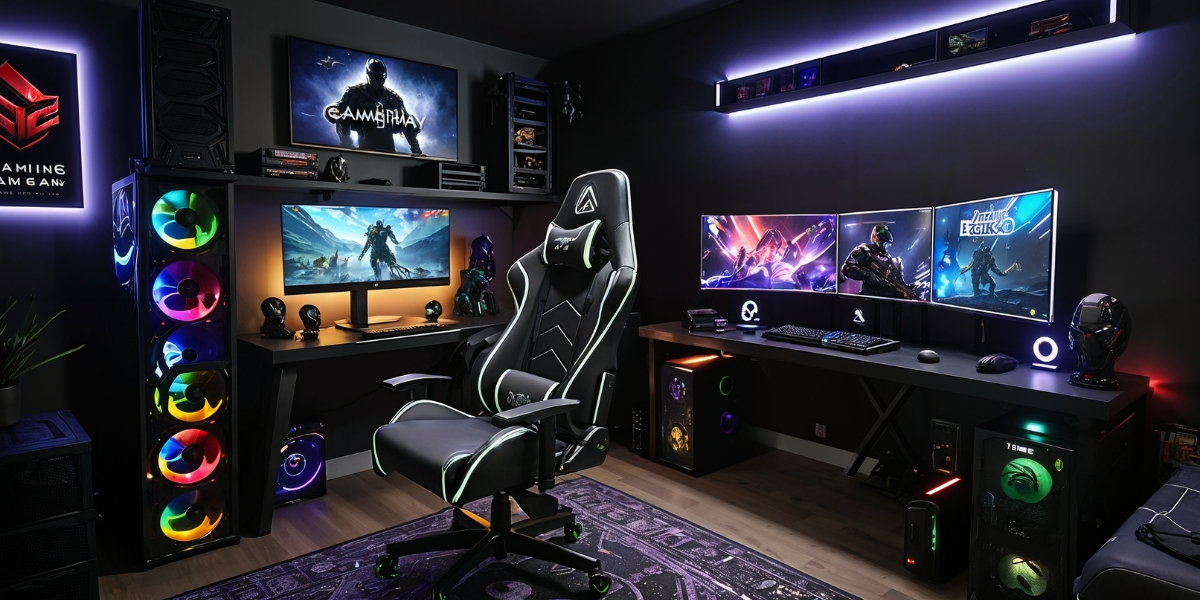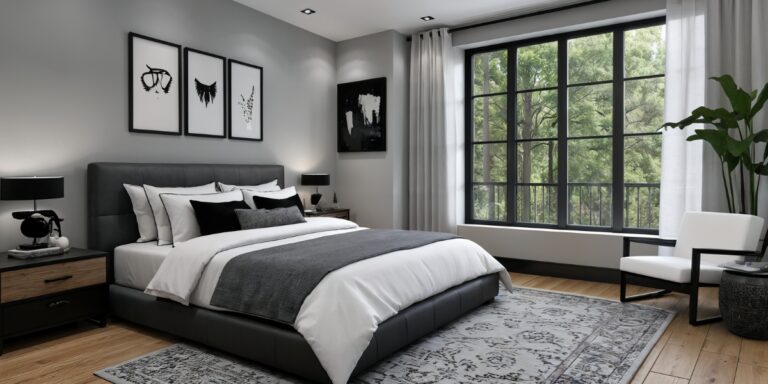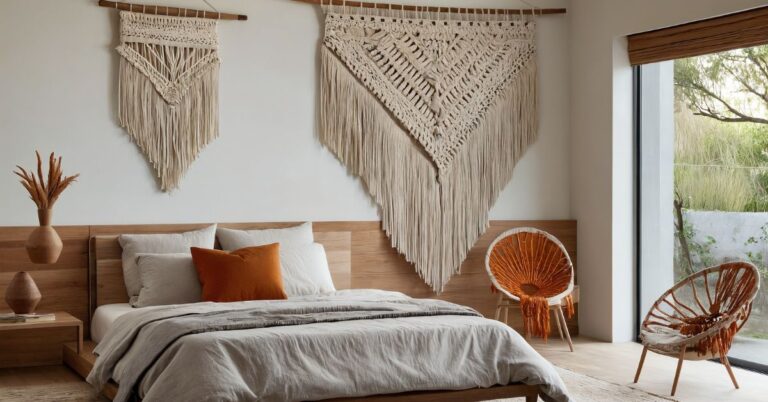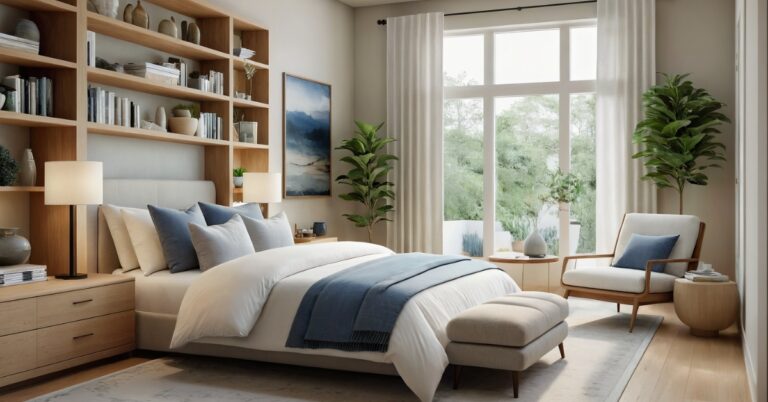In my experience working with homeowners on bedroom office conversions, I’ve observed that creating effective computer workspaces within bedrooms often requires balancing functionality with comfort and personal style. Through various projects, I’ve learned that thoughtful setup design typically enhances both productivity and living quality while addressing the unique challenges of combining work and rest spaces.
Note: For any electrical work, wall mounting installations, or structural modifications mentioned in this article, always consult with licensed professionals to ensure safety and code compliance.
What makes bedroom computer setups particularly effective is their ability to serve multiple purposes while maintaining the room’s primary function as a restful space. I’ve found that homeowners often choose bedroom workspaces because they typically provide privacy and flexibility while maximizing available space in smaller homes.
The key to successful bedroom computer setup design often lies in creating ergonomic, organized environments that support various activities without overwhelming the room’s atmosphere. Effective designs typically prioritize comfort, functionality, and visual appeal while ensuring adequate separation between work and sleep areas.
Here are 21 computer setup ideas for bedrooms that often work well in various home configurations, based on observations from numerous workspace renovation projects.
1. Minimalist Workspace Design: Clean Productivity Focus
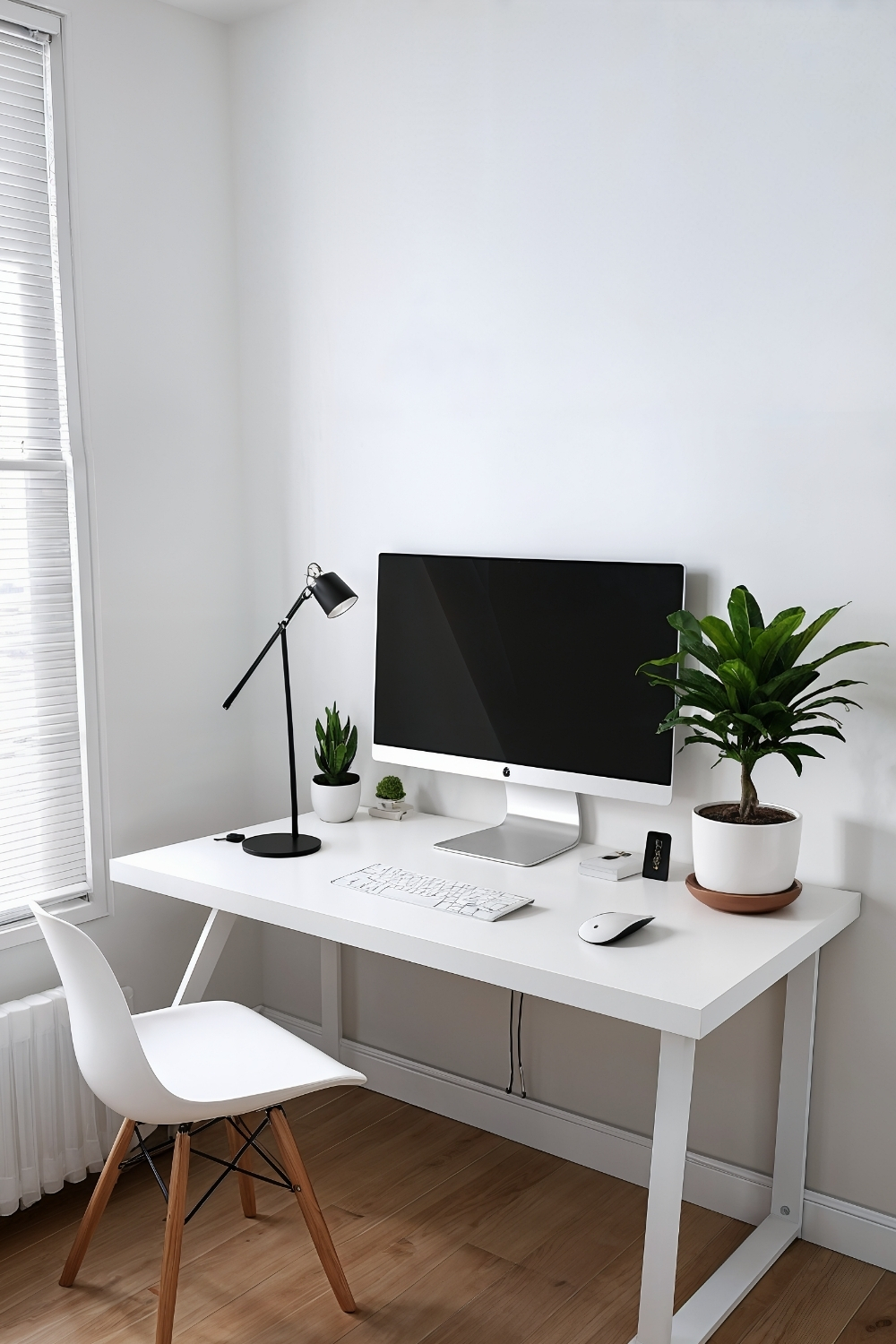
This setup approach often appeals to homeowners seeking distraction-free work environments. Clean desks with essential equipment—monitors, wireless peripherals, and organized cable management—typically create calming, focused workspaces.
Design consideration: Neutral color palettes often reduce visual distractions, while hidden cable management systems typically maintain the clean aesthetic essential to minimalist design principles.
Practical benefit: Simplified setups often reduce decision fatigue, while clean surfaces typically make daily maintenance and organization routines more manageable and stress-free.
2. Gaming-Optimized Setup: Entertainment Command Centers
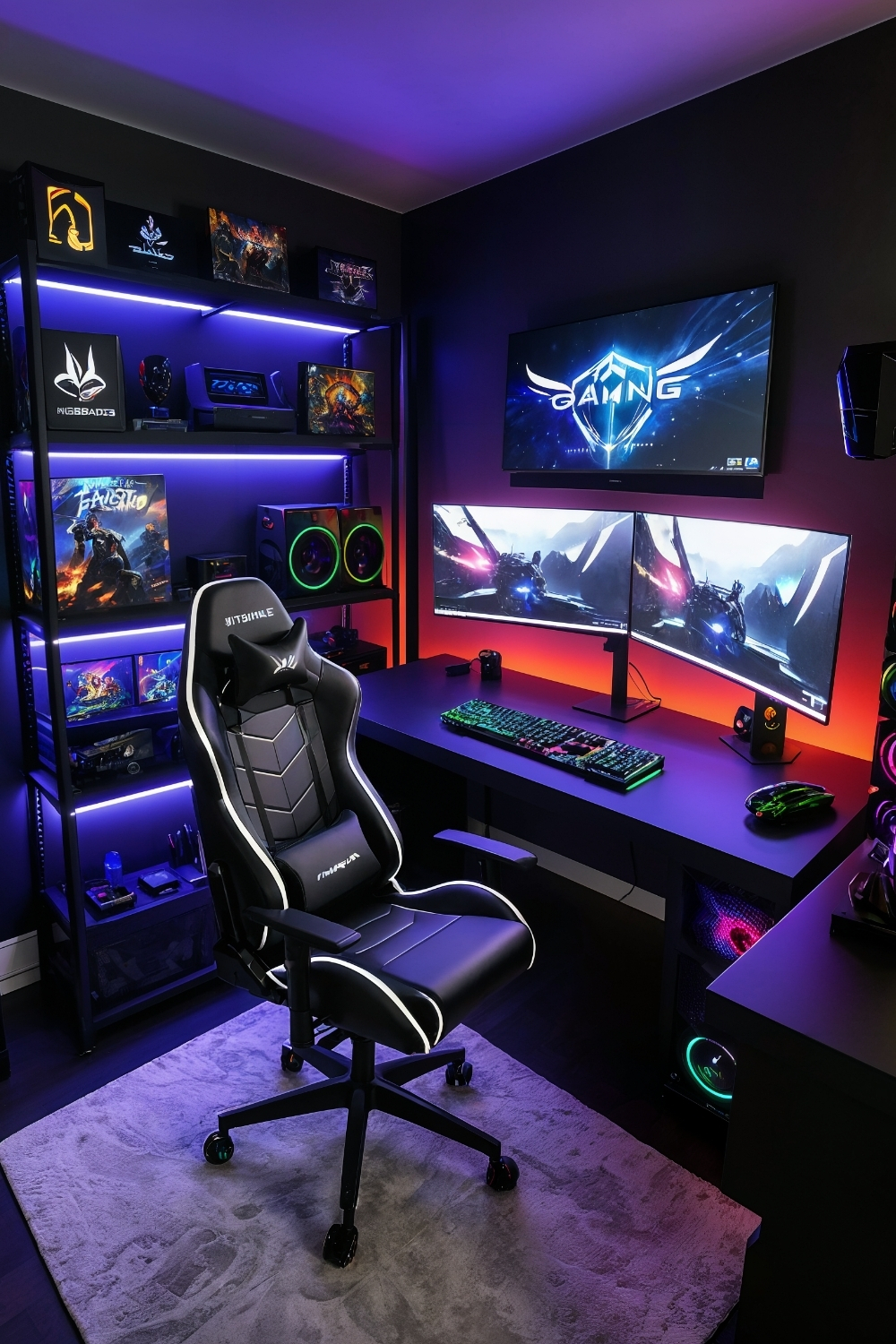
This configuration often appeals to homeowners prioritizing gaming performance and immersion. Gaming chairs, dual monitors, custom PCs, and RGB lighting systems typically create dedicated entertainment environments.
Design consideration: Acoustic foam panels often improve sound quality while reducing noise transmission, and proper ventilation typically ensures equipment operates optimally during extended gaming sessions.
Practical benefit: Dedicated gaming setups often provide better performance and comfort during long sessions, while organized configurations typically protect expensive equipment investments.
3. Ergonomic Health-Focused Design: Posture-Supporting Workstations
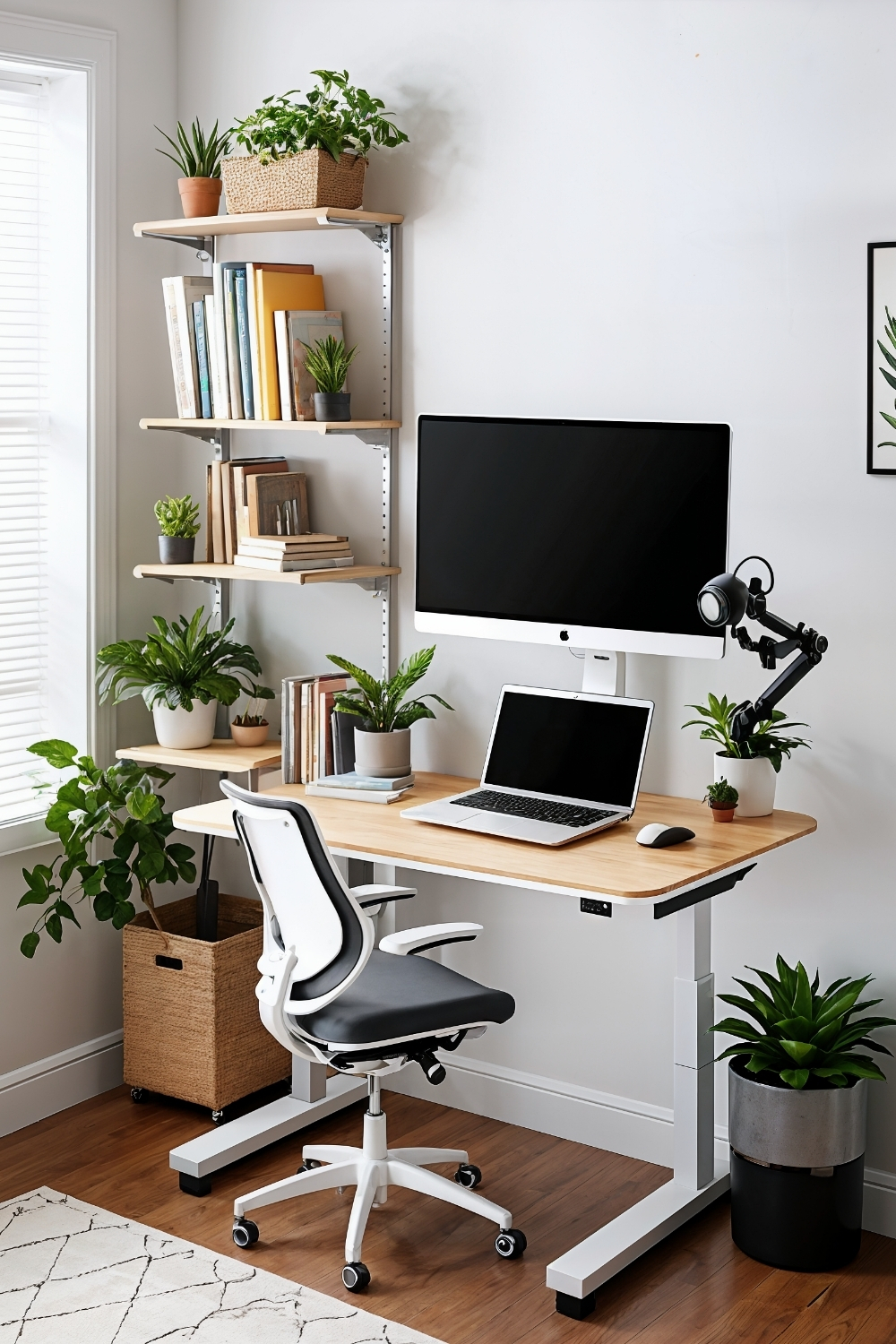
This setup strategy often appeals to homeowners spending extended periods at computer workstations. Adjustable standing desks, ergonomic seating, and monitor positioning typically support healthy posture and reduce strain.
Design consideration: Monitor mounts often ensure proper screen positioning at eye level, while adjustable furniture typically accommodates different users and work preferences throughout the day.
Practical benefit: Ergonomic investments often prevent long-term health issues, while comfort improvements typically increase productivity and reduce fatigue during work sessions.
4. Corner Workspace Solutions: Space-Maximizing Configurations
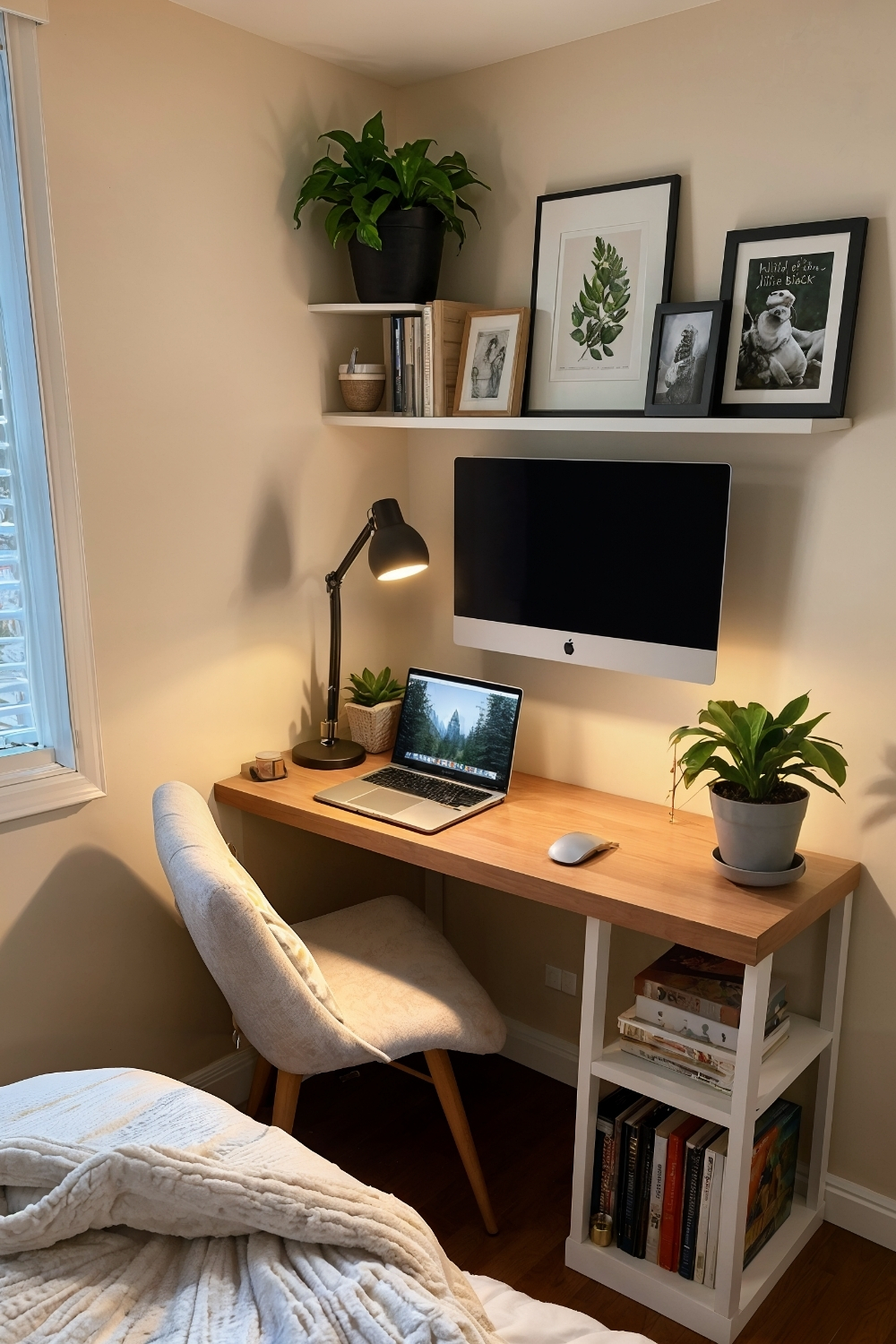
This layout approach often appeals to homeowners with limited bedroom space. Corner desks with vertical storage typically utilize often-overlooked areas while providing functional workspace without overwhelming room layouts.
Design consideration: Vertical shelving often maximizes storage capacity, while compact footprints typically leave more floor space available for bedroom furniture and movement.
Practical benefit: Corner utilization often creates workspace without sacrificing bedroom functionality, while efficient designs typically cost less than dedicated office room conversions.
5. Wall-Mounted Floating Systems: Modern Space Solutions
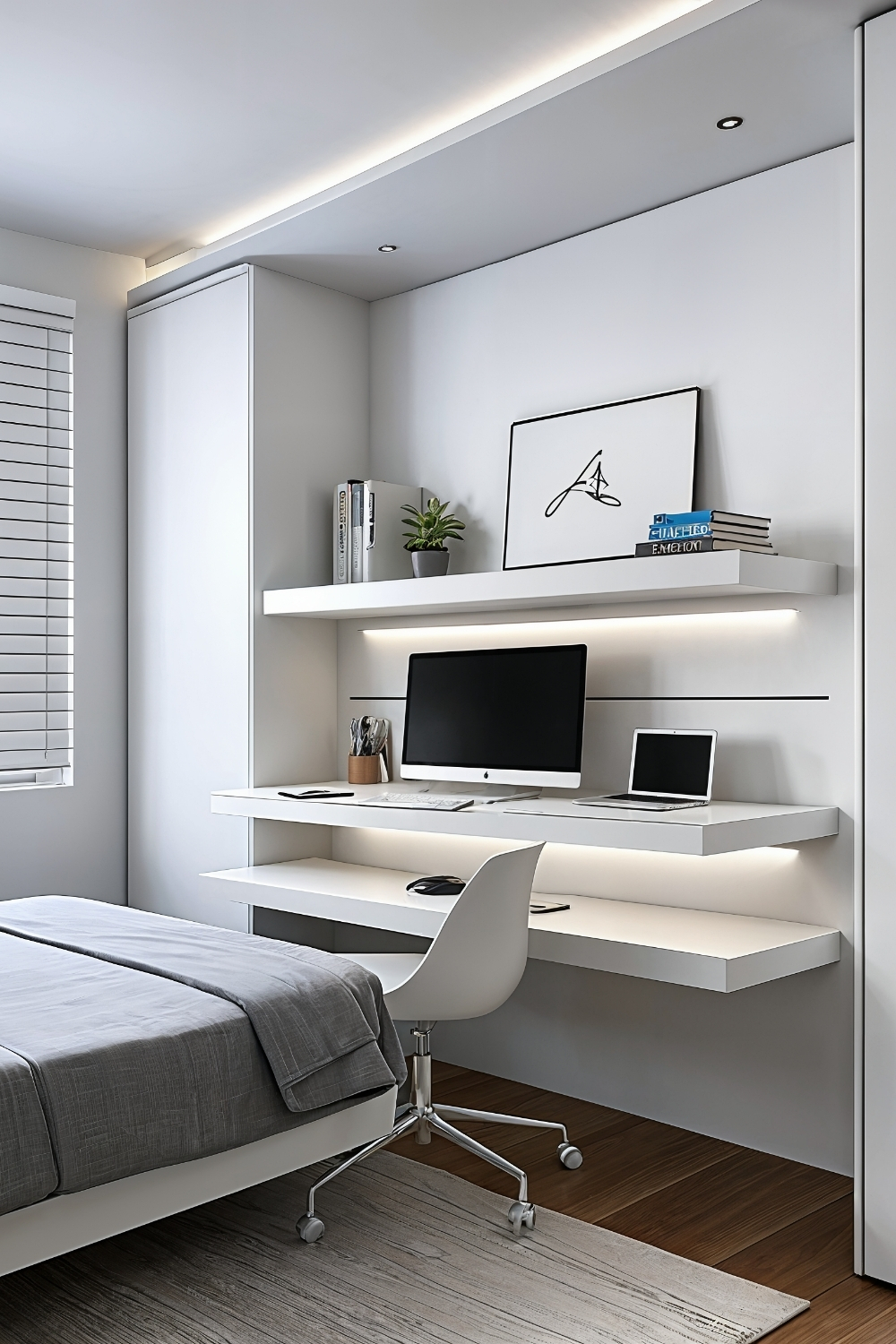
This installation method often appeals to homeowners seeking contemporary, space-saving designs. Wall-mounted desks and floating shelves typically create modern appearances while preserving valuable floor space.
Design consideration: Proper wall mounting often requires adequate structural support, while hidden storage typically maintains clean sight lines essential to floating design aesthetics.
Practical benefit: Floating installations often make floor cleaning easier, while modern appearances typically increase property value and aesthetic appeal over time.
6. Nature-Integrated Workspaces: Biophilic Design Elements
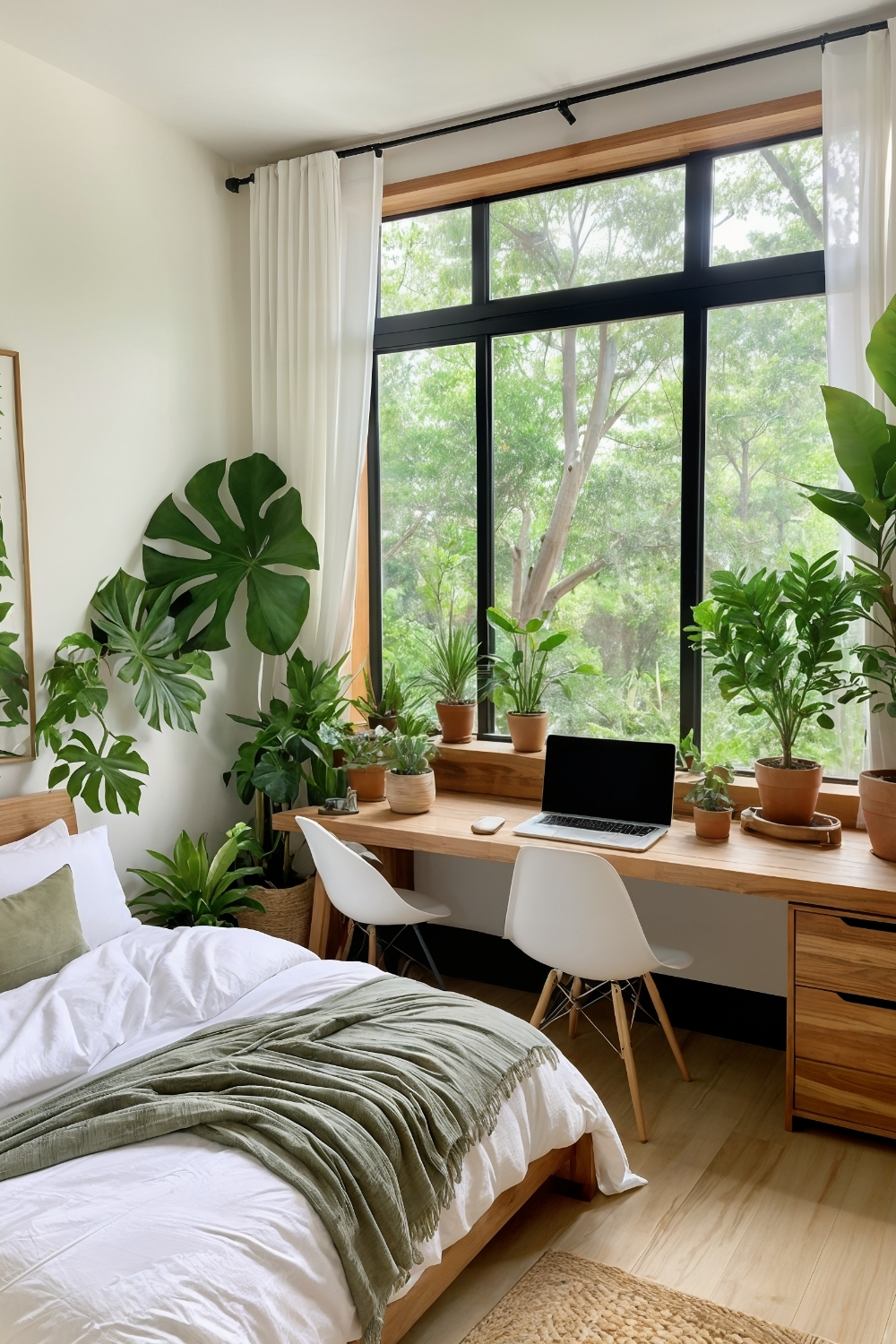
This design philosophy often appeals to homeowners seeking calming, refreshing work environments. Natural materials, plants, and natural lighting typically create peaceful atmospheres that reduce stress and improve focus.
Design consideration: Plant selection often requires consideration of available light and maintenance requirements, while natural materials typically need appropriate care to maintain appearance over time.
Practical benefit: Biophilic elements often improve air quality and mental well-being, while natural lighting typically reduces eye strain and energy costs during daytime work.
7. Dual-Purpose Configuration: Work-Entertainment Balance
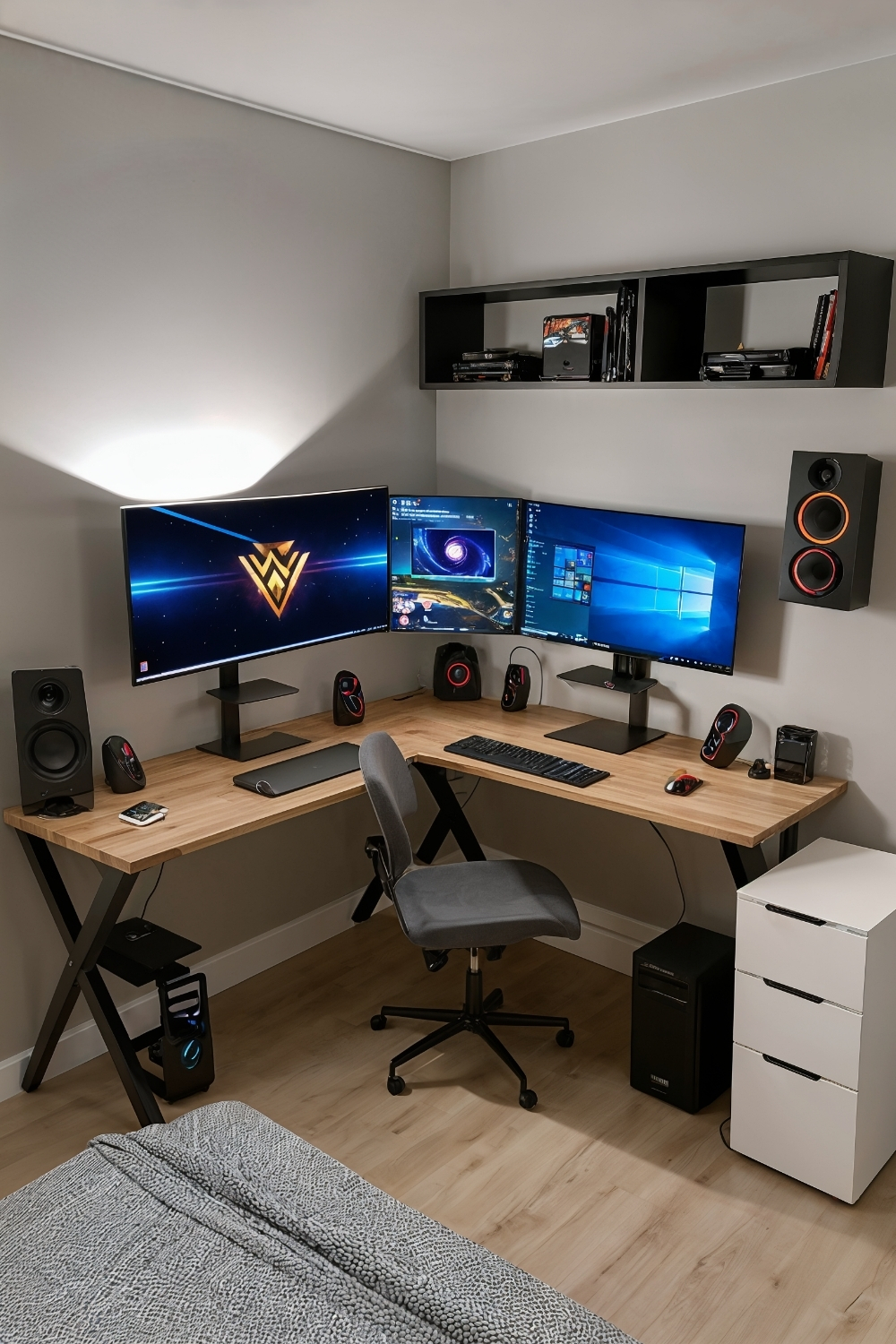
This setup strategy often appeals to homeowners needing both professional and leisure functionality. L-shaped desks with dedicated work and entertainment zones typically provide flexibility while maintaining organization.
Design consideration: Clear zone separation often prevents work-life boundary blur, while shared resources like internet and power typically reduce setup complexity and costs.
Practical benefit: Dual-purpose designs often maximize equipment utility, while flexible configurations typically adapt to changing work and entertainment needs over time.
8. Ultra-Wide Monitor Integration: Single-Screen Solutions
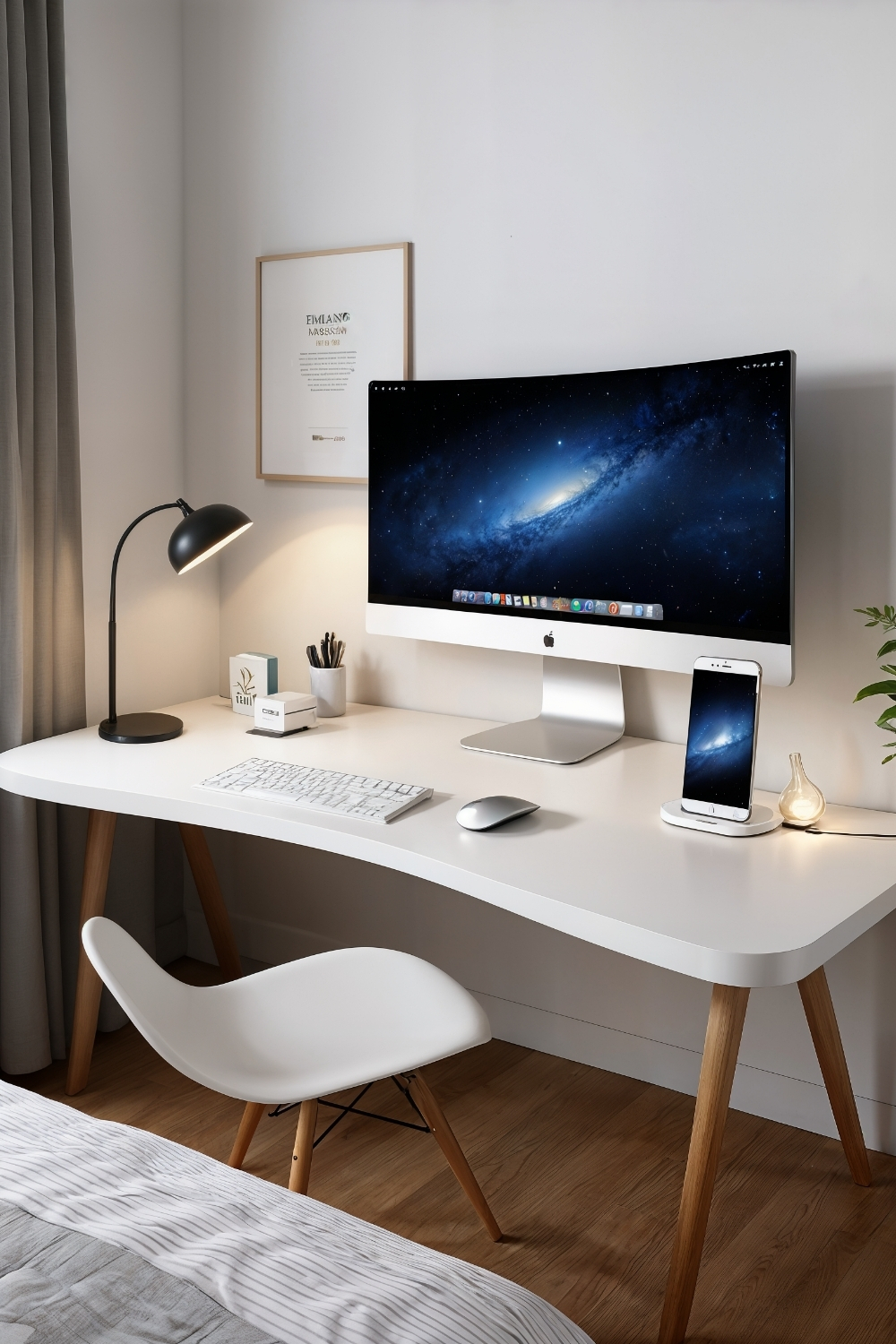
This display approach often appeals to homeowners seeking streamlined, high-productivity setups. Ultra-wide curved monitors typically provide extensive screen real estate while maintaining clean, uncluttered desk surfaces.
Design consideration: Monitor positioning often requires proper distance and height adjustment for comfort, while cable management typically becomes simpler with single-display configurations.
Practical benefit: Ultra-wide displays often improve multitasking efficiency, while single-monitor setups typically reduce eye movement fatigue and desktop clutter.
9. Retro-Themed Designs: Vintage-Inspired Workstations
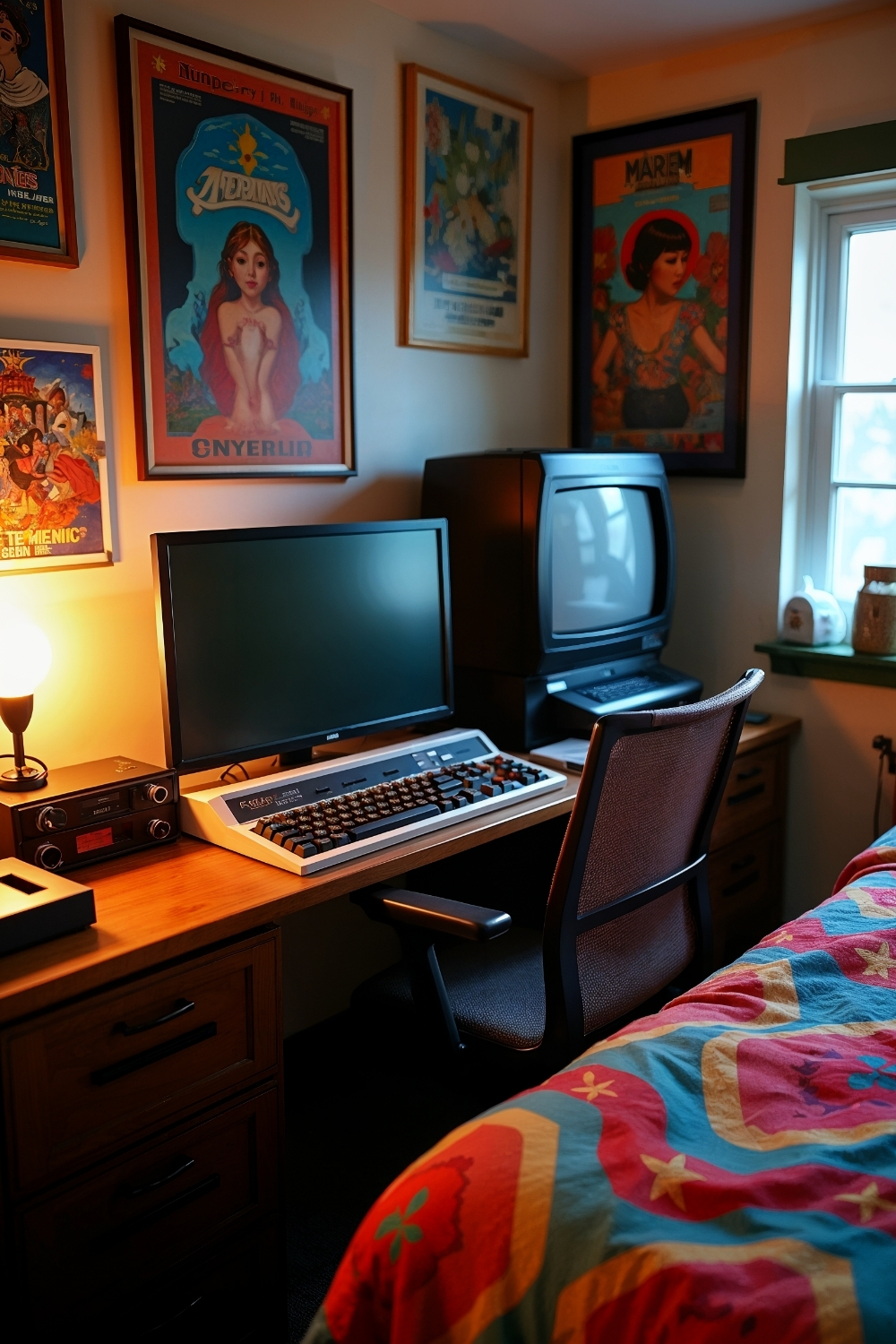
This aesthetic approach often appeals to homeowners appreciating nostalgic technology design. Vintage-style keyboards, retro monitors, and period-appropriate accessories typically create unique, personality-filled workspaces.
Design consideration: Modern functionality often remains important despite vintage aesthetics, while authentic vintage pieces typically require consideration of compatibility with current technology standards.
Practical benefit: Unique designs often provide personal satisfaction and conversation value, while retro elements typically create distinctive spaces that reflect individual personality and interests.
10. Monochromatic Color Schemes: Unified Visual Design
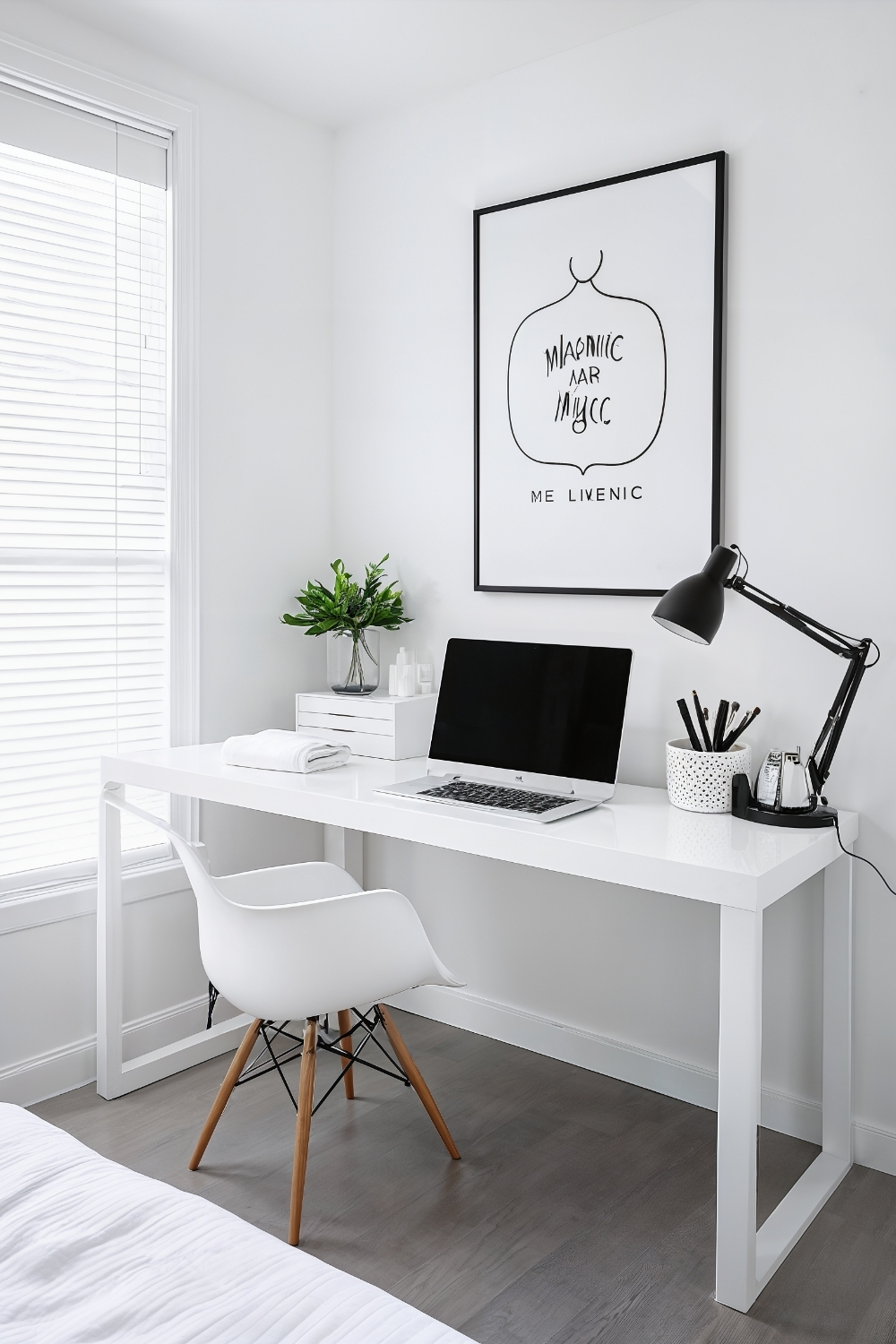
This color strategy often appeals to homeowners seeking sophisticated, professional appearances. Single-color palettes in whites, blacks, or grays typically create cohesive, elegant workspaces.
Design consideration: Matching accessories often reinforce color themes, while texture variations typically add visual interest without breaking monochromatic harmony.
Practical benefit: Unified color schemes often create calming environments, while coordinated aesthetics typically make accessory selection and room integration more straightforward.
11. RGB Lighting Integration: Customizable Ambiance Systems
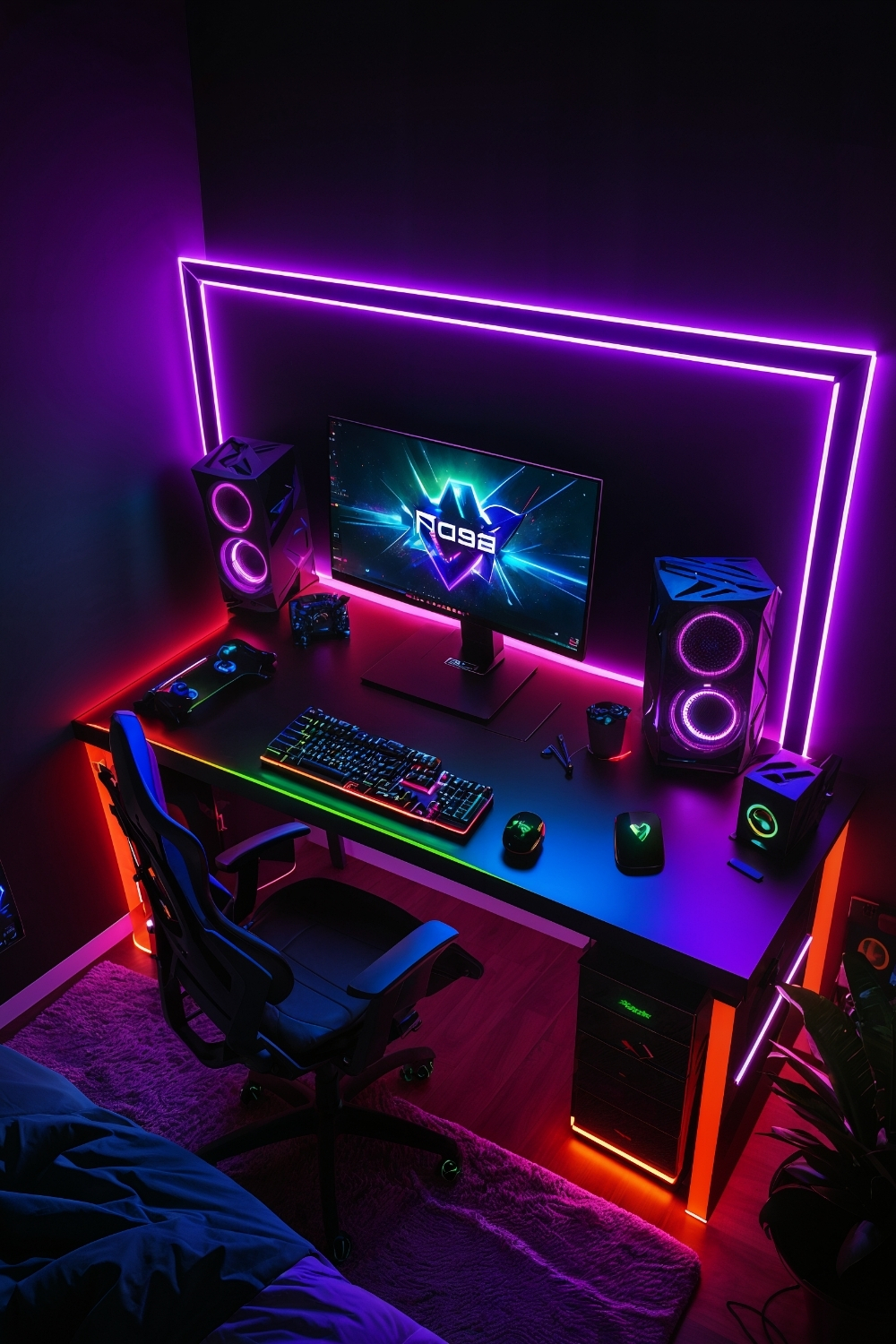
This lighting approach often appeals to homeowners wanting dynamic, personalized environments. LED strips, customizable keyboard lighting, and color-changing accessories typically create vibrant, mood-responsive workspaces.
Design consideration: Lighting control systems often allow scene customization for different activities, while proper placement typically ensures even illumination without glare or eye strain.
Practical benefit: Customizable lighting often improves mood and focus, while programmable systems typically adapt to different work requirements and time-of-day preferences.
12. Hidden Storage Integration: Organized Minimalism
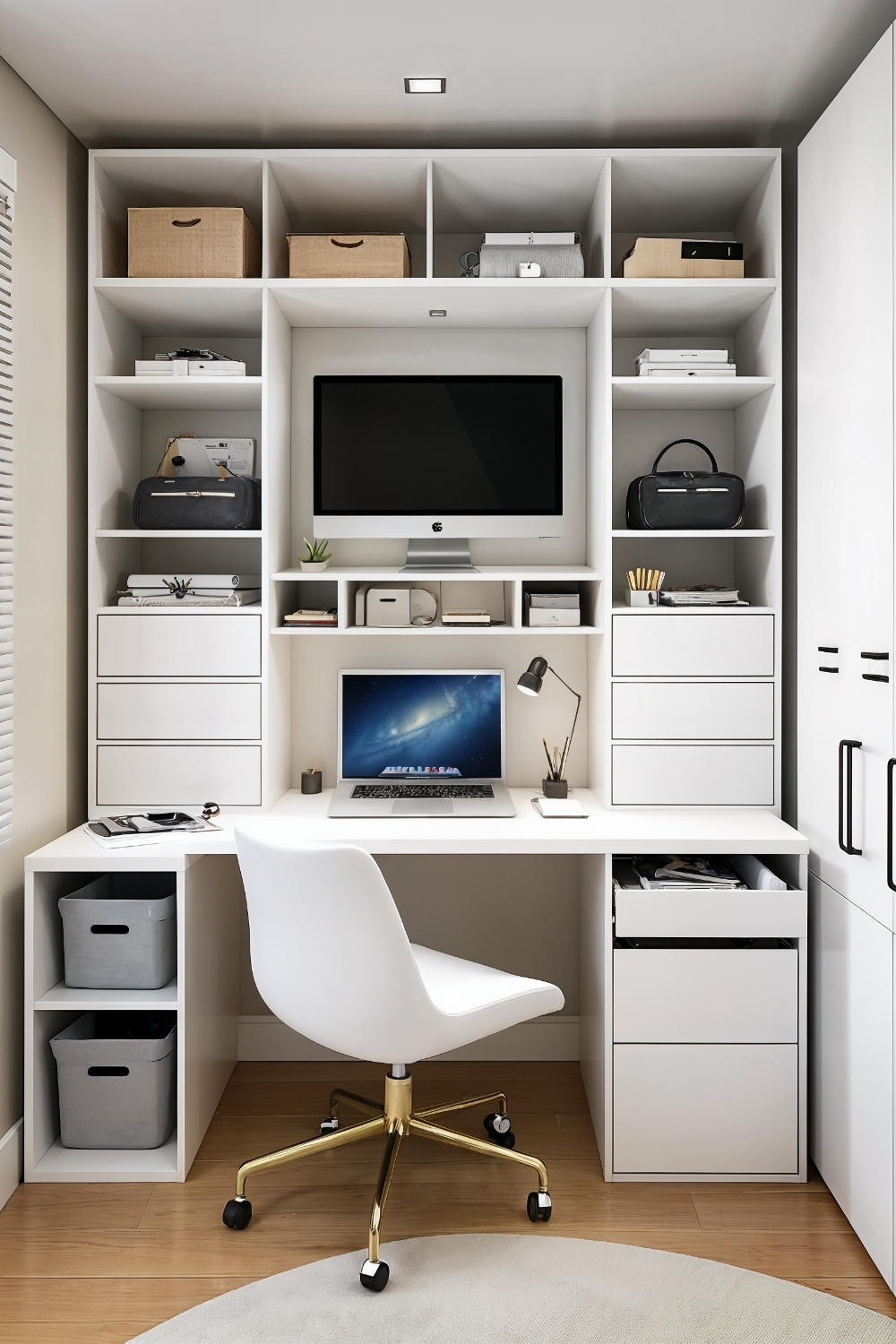
This organization strategy often appeals to homeowners maintaining clean appearances while accommodating numerous accessories. Concealed storage, cable organizers, and hidden compartments typically keep equipment accessible yet invisible.
Design consideration: Storage accessibility often requires balance between concealment and daily usability, while organizational systems typically need regular maintenance to remain effective.
Practical benefit: Hidden storage often reduces visual clutter and stress, while organized systems typically improve efficiency and protect equipment from dust and damage.
13. Multi-Monitor Configurations: Expanded Screen Real Estate
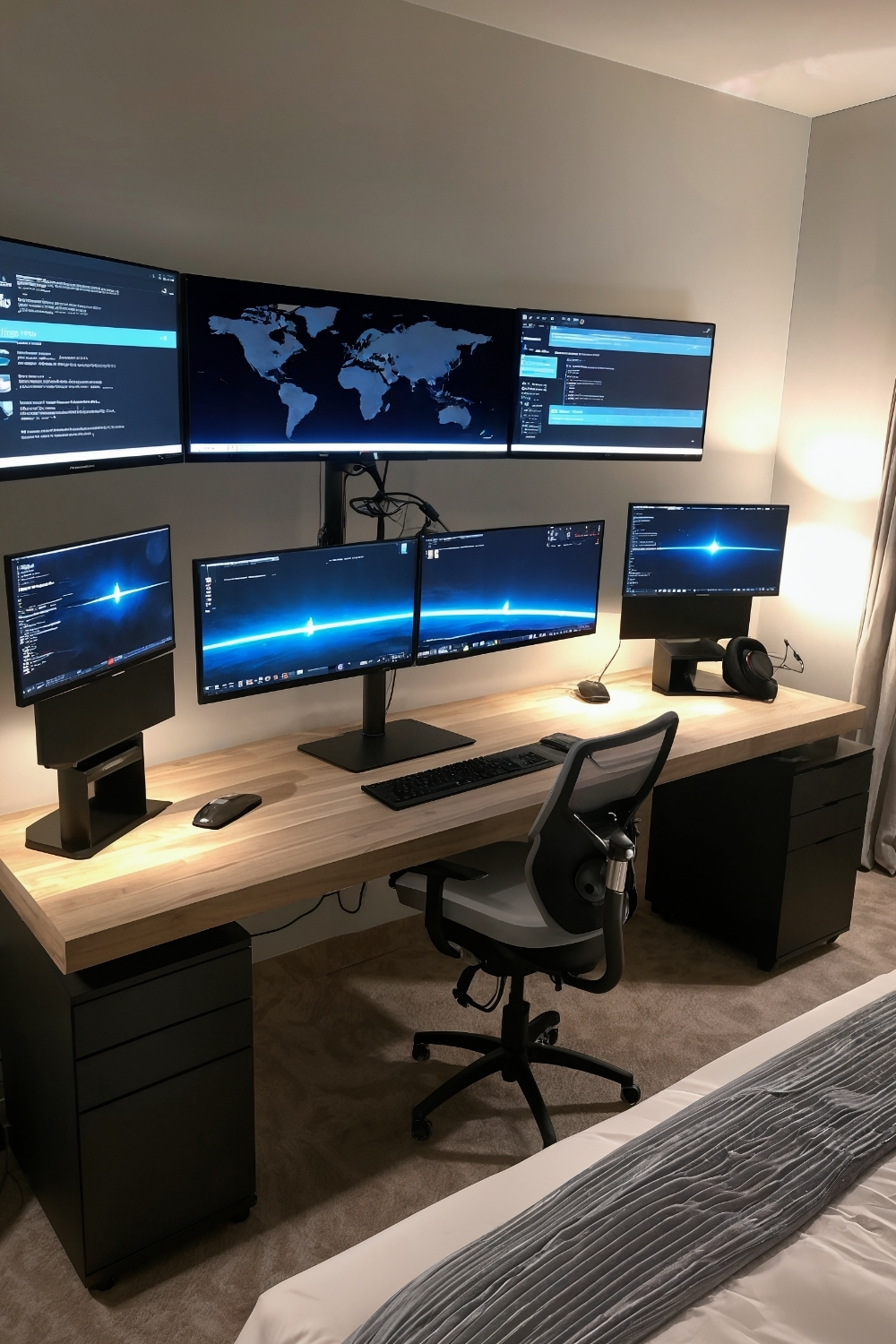
This display strategy often appeals to homeowners requiring extensive multitasking capabilities. Multiple monitors with proper mounting systems typically support complex workflows while maintaining ergonomic positioning.
Design consideration: Monitor alignment often requires careful adjustment for comfort, while mounting systems typically need adequate structural support and cable management planning.
Practical benefit: Multiple displays often dramatically improve productivity for complex tasks, while proper configurations typically reduce window management time and frustration.
14. Ambient Lighting Design: Mood-Enhanced Environments
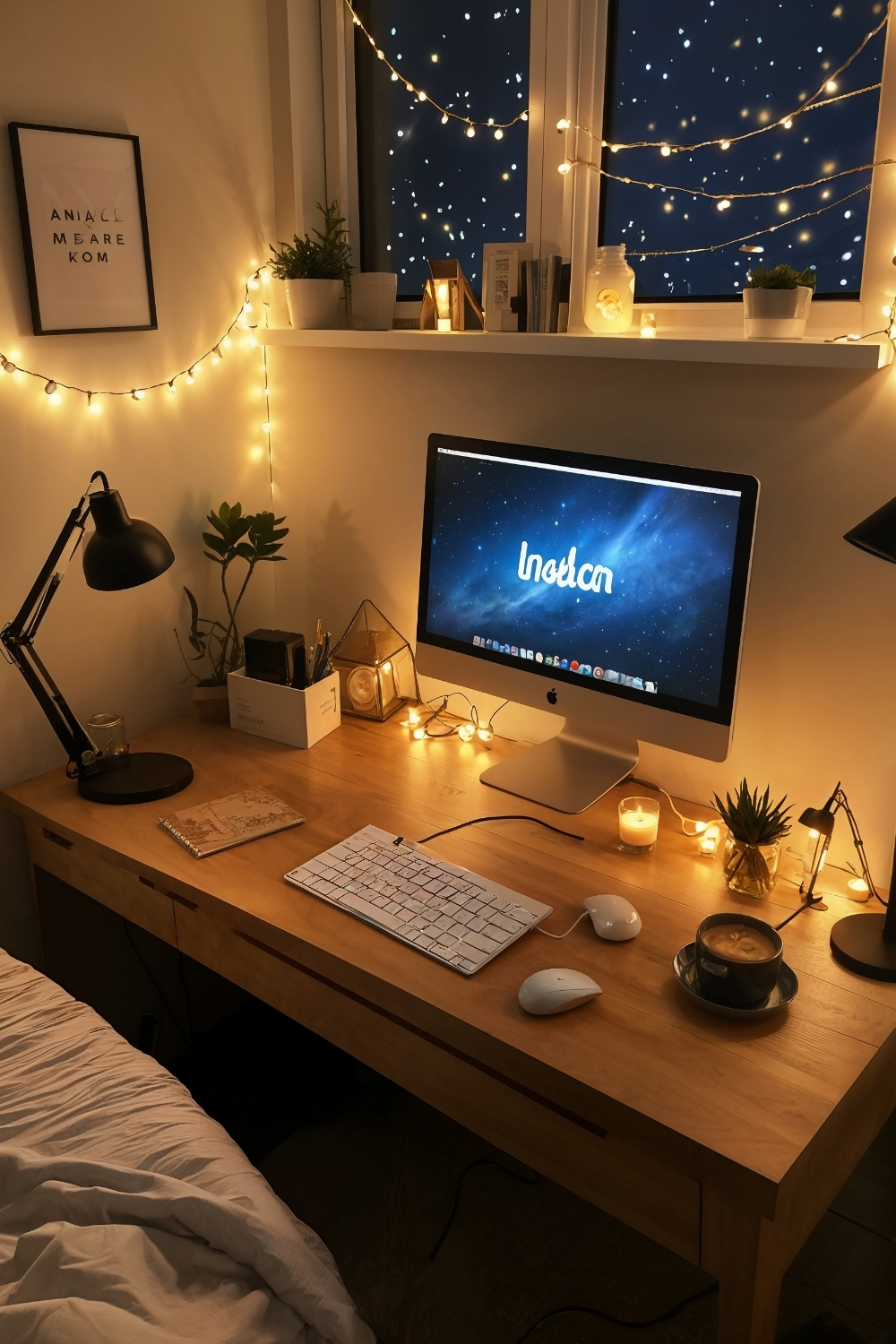
This illumination approach often appeals to homeowners creating relaxing, comfortable workspaces. Soft desk lamps, warm LED strips, and accent lighting typically create cozy atmospheres that reduce eye strain.
Design consideration: Light temperature often affects circadian rhythms and productivity, while layered lighting typically provides flexibility for different activities and times of day.
Practical benefit: Proper ambient lighting often reduces headaches and eye fatigue, while comfortable environments typically improve focus and extend productive work periods.
15. Compact Space Solutions: Efficiency-Optimized Setups
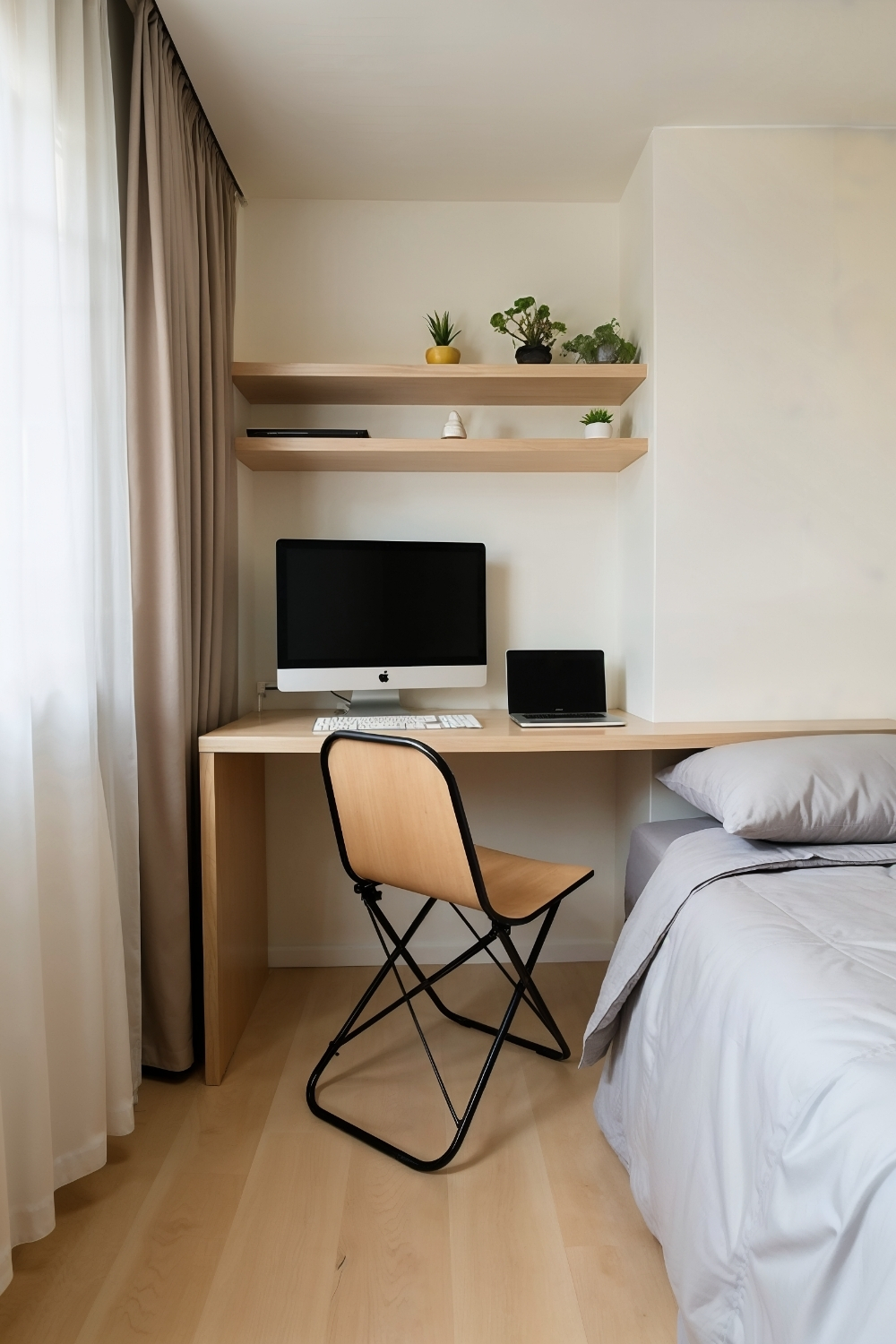
This design approach often appeals to homeowners with severely limited bedroom space. Folding furniture, laptop-based setups, and multi-functional accessories typically provide necessary functionality without permanent space commitment.
Design consideration: Storage solutions often need quick setup and breakdown capabilities, while portable equipment typically requires organized storage systems when not in use.
Practical benefit: Compact solutions often cost less and provide flexibility, while efficient designs typically work well for occasional users or temporary living situations.
16. Bedside Workspace Integration: Comfort-Focused Solutions
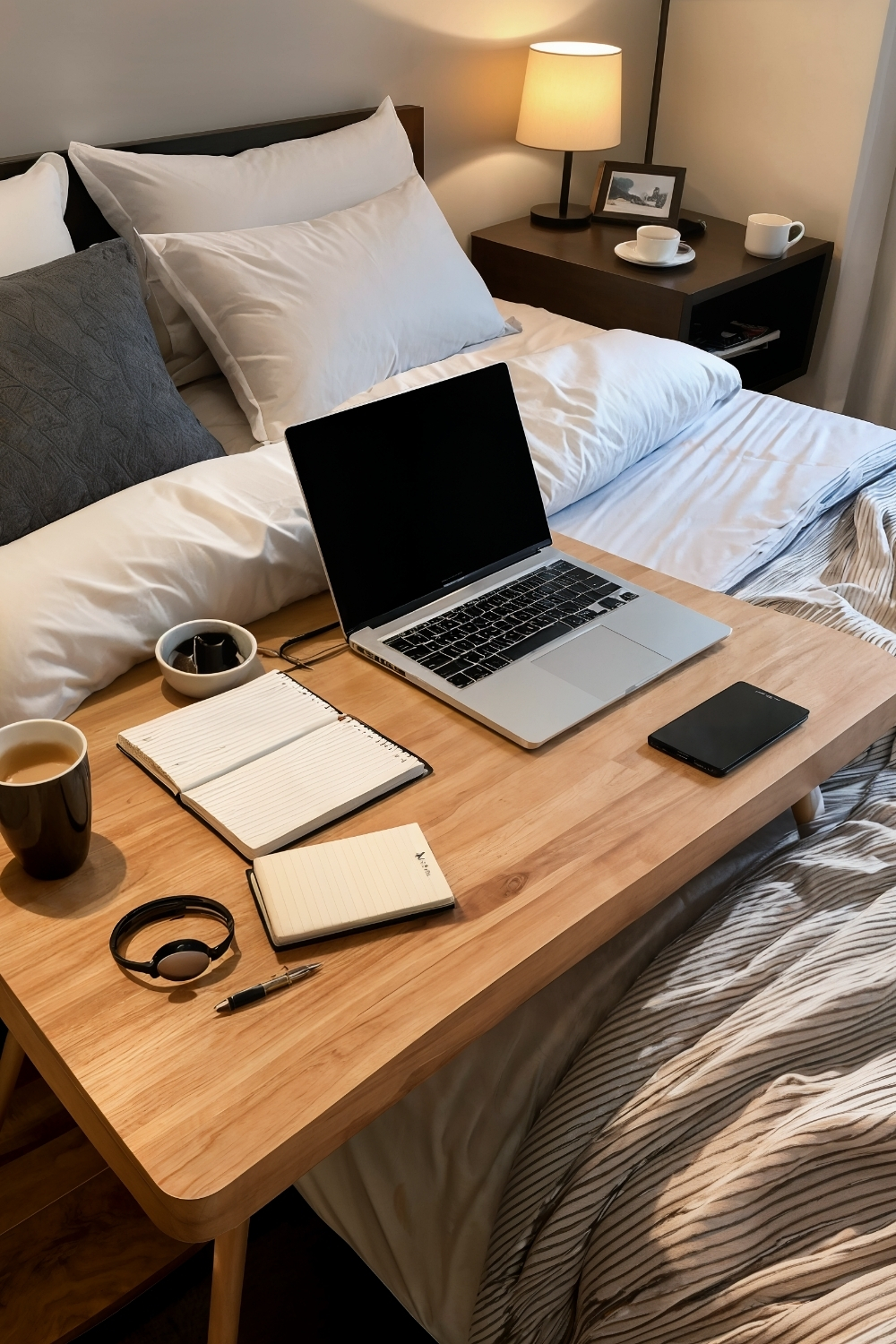
This setup method often appeals to homeowners wanting maximum comfort and flexibility. Adjustable bed desks and ergonomic support systems typically enable productive work from bed while maintaining proper posture.
Design consideration: Proper support often prevents strain during extended use, while stability systems typically ensure safe laptop and accessory positioning on soft surfaces.
Practical benefit: Bedside work often provides comfort during illness or fatigue, while flexible positioning typically accommodates various work preferences and physical needs.
17. Wall-Mounted Display Systems: Space-Efficient Viewing
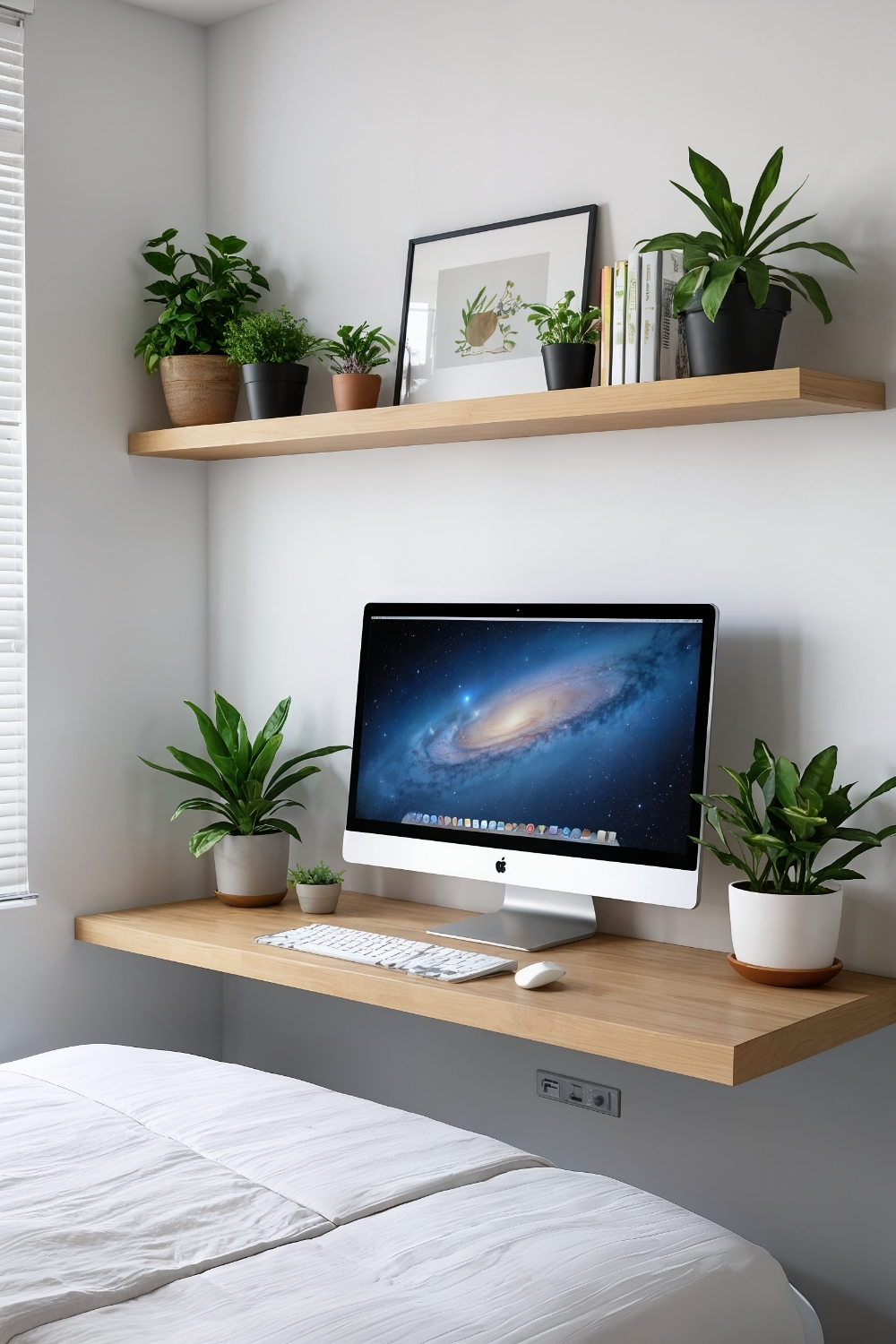
This mounting approach often appeals to homeowners maximizing limited desk space. Wall-mounted monitors with floating accessory shelves typically provide full functionality while preserving valuable work surfaces.
Design consideration: Proper mounting height often requires consideration of seating positions, while wall structure typically needs evaluation for adequate support capacity.
Practical benefit: Wall mounting often creates cleaner desk surfaces, while fixed positioning typically provides consistent ergonomic viewing angles for daily use.
18. Artistic Environment Integration: Creative Workspace Design
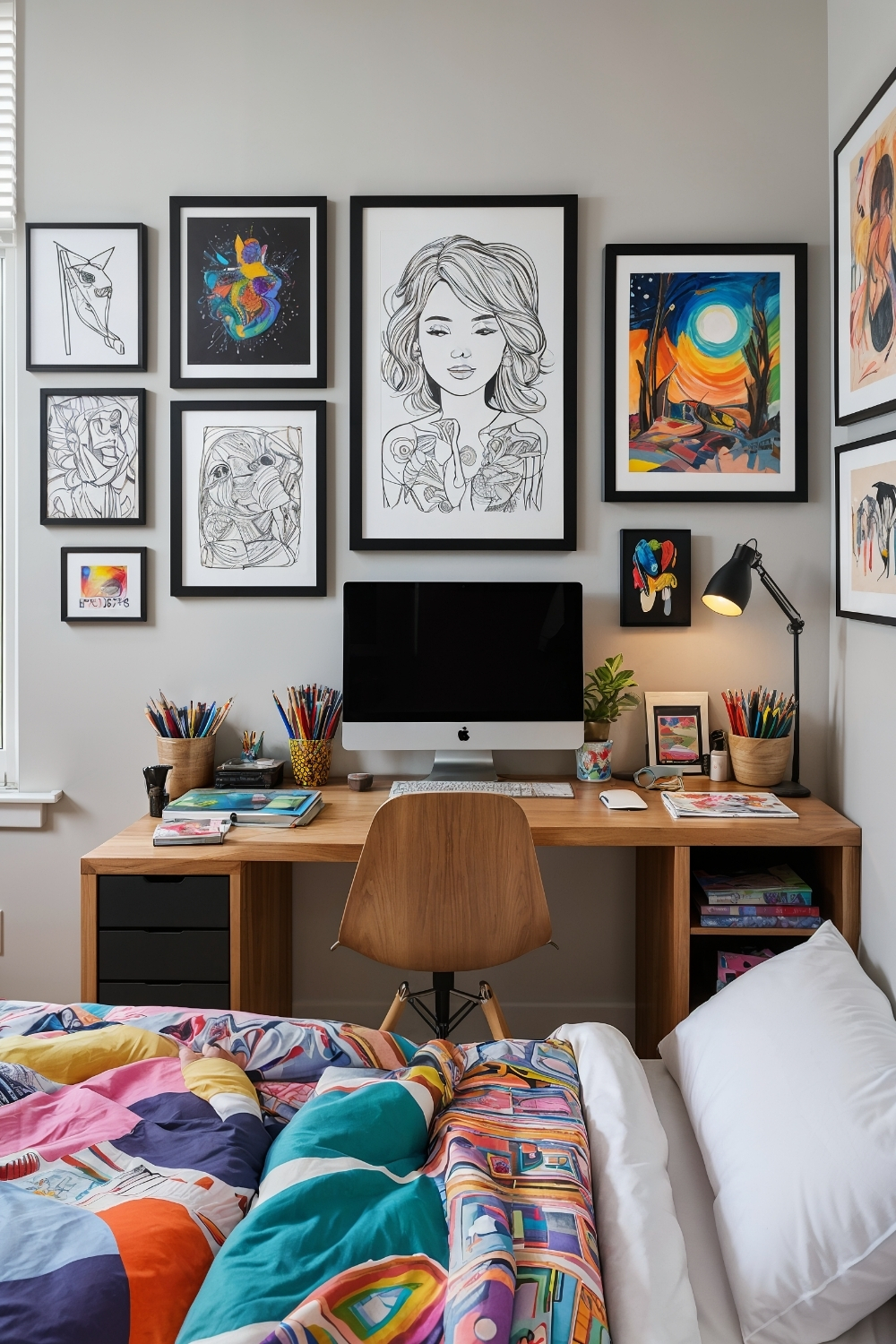
This decorative approach often appeals to homeowners seeking inspiring, personalized work environments. Curated artwork, creative displays, and personal collections typically create motivating spaces that reflect individual interests.
Design consideration: Art placement often requires balance with functional needs, while personal collections typically need organization systems that prevent workspace clutter.
Practical benefit: Inspiring environments often improve creativity and job satisfaction, while personalized spaces typically create stronger emotional connections to work activities.
19. Smart Technology Integration: Voice-Controlled Workspaces
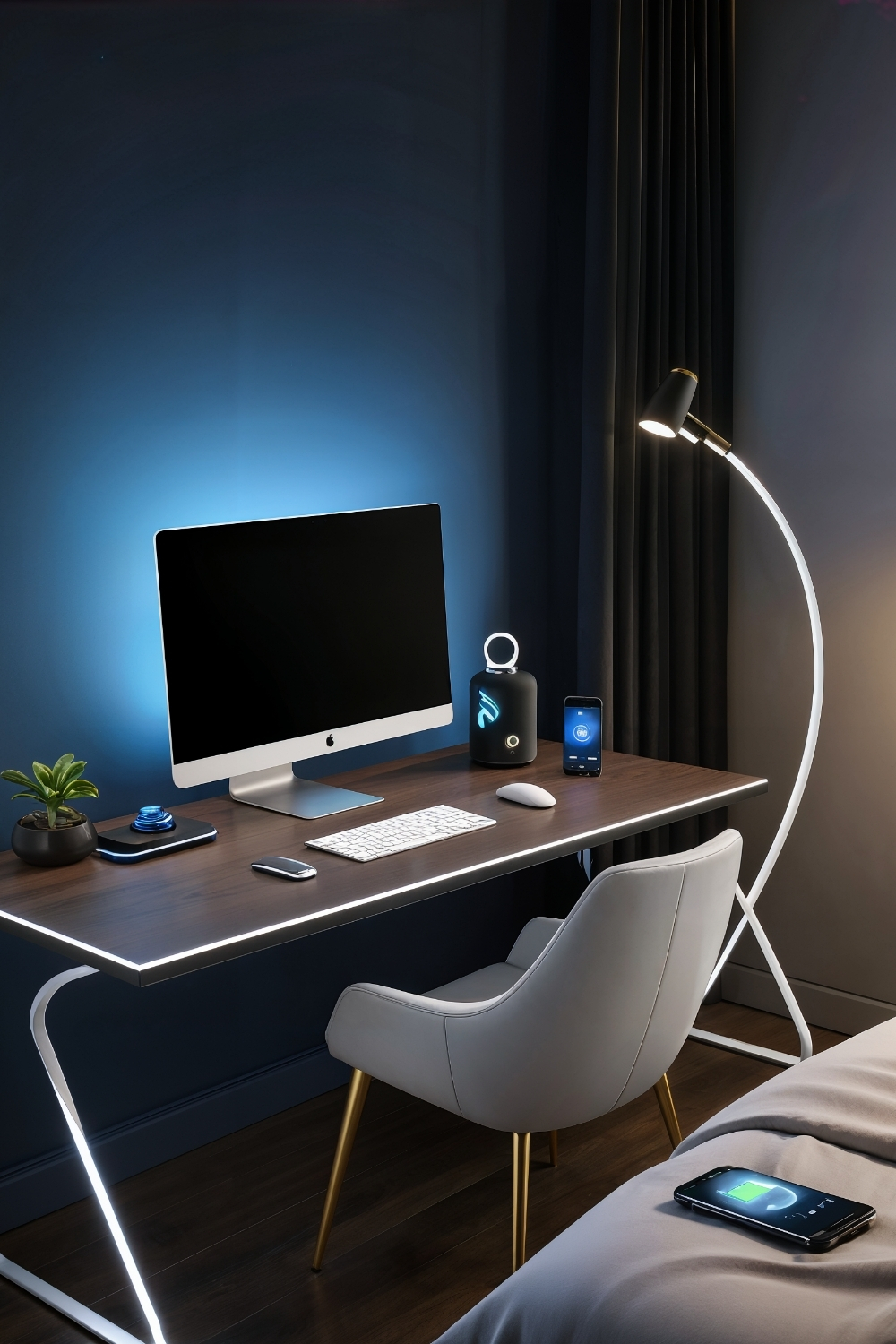
This automation approach often appeals to homeowners embracing connected home technology. Smart lighting, voice assistants, and automated systems typically create convenient, futuristic work environments.
Design consideration: Device compatibility often requires research and planning, while network requirements typically need adequate internet infrastructure for reliable operation.
Practical benefit: Smart systems often improve convenience and efficiency, while voice control typically reduces interruptions during focused work sessions.
20. Themed Environment Design: Immersive Workspace Aesthetics
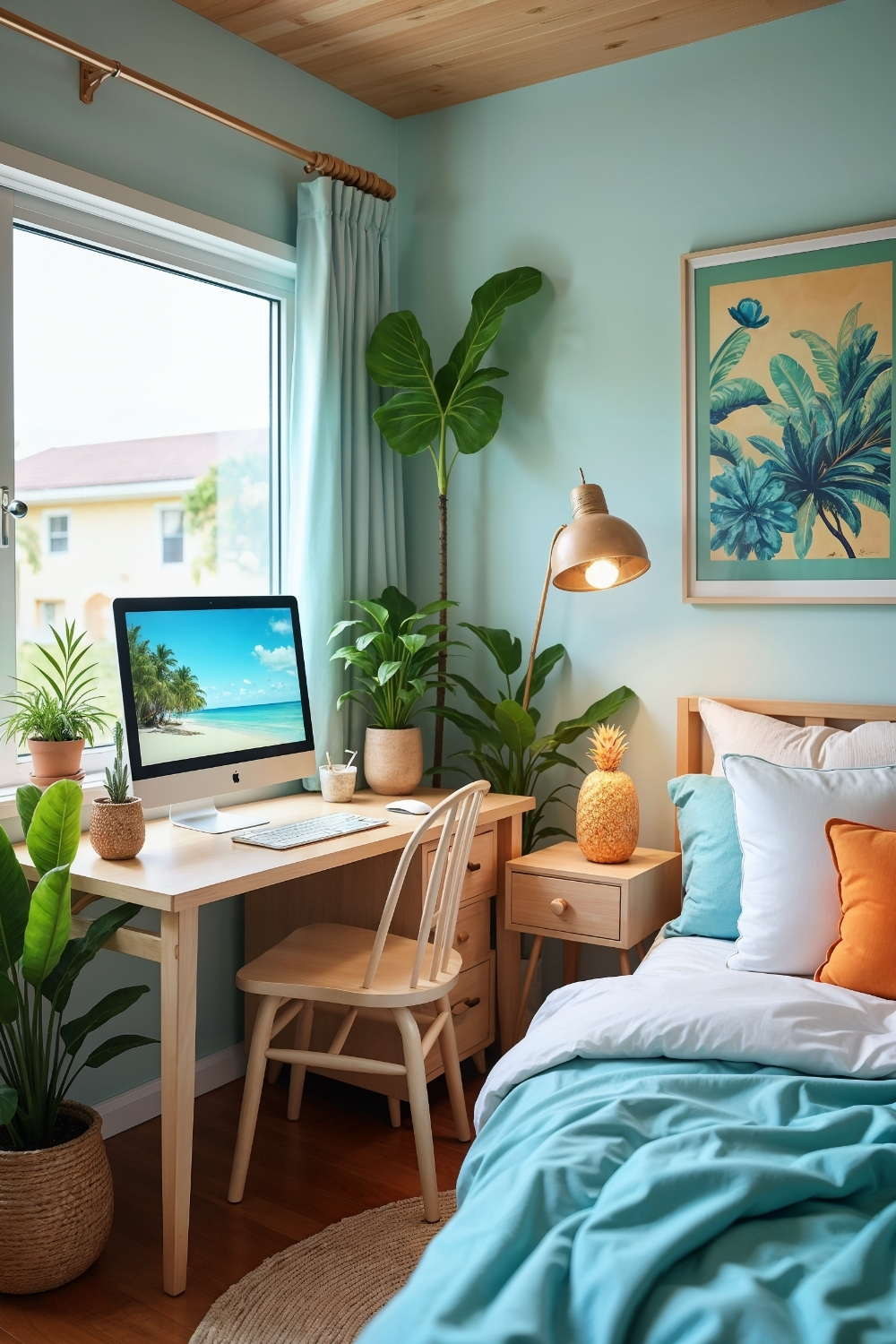
This decorative strategy often appeals to homeowners wanting unique, mood-enhancing environments. Coordinated themes with appropriate colors, accessories, and ambient elements typically create distinctive, enjoyable workspaces.
Design consideration: Theme consistency often requires careful accessory selection, while practical functionality typically needs integration with decorative elements for daily usability.
Practical benefit: Themed environments often provide psychological benefits and personal satisfaction, while unique designs typically create spaces that users genuinely enjoy occupying.
21. Futuristic Design Integration: High-Tech Aesthetic Solutions
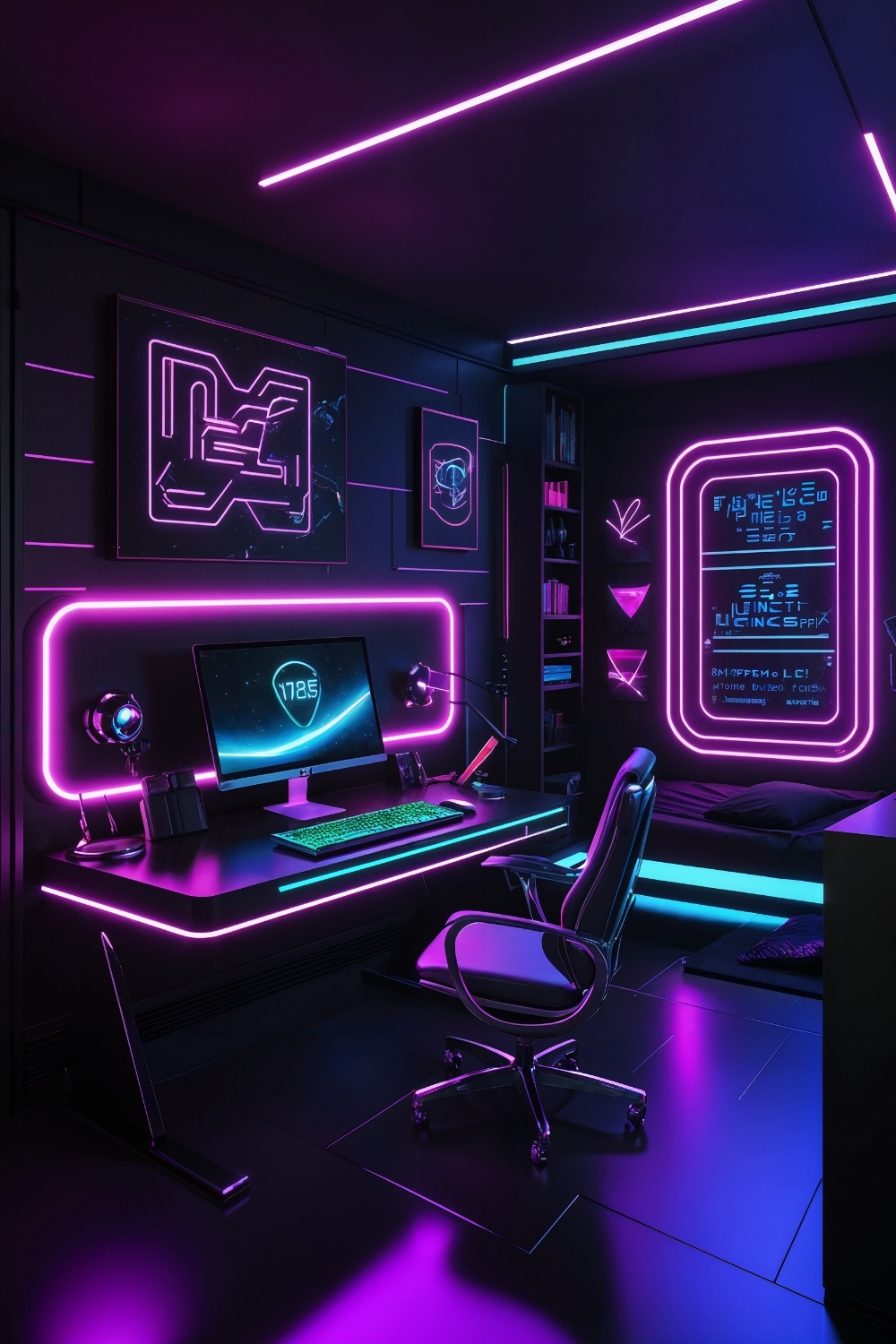
This styling approach often appeals to homeowners embracing cutting-edge technology aesthetics. LED accent lighting, sleek surfaces, and modern accessories typically create contemporary, forward-looking work environments.
Design consideration: Technology integration often requires adequate power and connectivity planning, while modern materials typically need appropriate maintenance to preserve appearances.
Practical benefit: Futuristic designs often provide motivation and enjoyment, while high-quality aesthetics typically create impressive spaces for video calls and professional interactions.
Creating Your Ideal Bedroom Computer Setup
Understanding these design approaches often helps homeowners create computer workspaces that successfully balance productivity needs with bedroom comfort and aesthetics. Effective implementations typically start with ergonomic considerations and space planning, then layer in personal style elements and technological requirements.
Successful bedroom computer setups often prioritize user health and comfort while ensuring adequate separation between work and sleep environments. The result typically creates spaces that enhance both productivity and living quality while reflecting individual preferences and work requirements.
When planning your bedroom workspace, consider how these elements work together to support your specific activities while maintaining the room’s restful atmosphere. The most effective designs often focus on flexibility and organization, which typically adapt to changing work needs while preserving bedroom functionality.
Remember: For any wall mounting installations, electrical work for lighting or power systems, or structural modifications related to bedroom computer setup installations, always consult with licensed professionals to ensure proper installation, safety, and local building code compliance.

